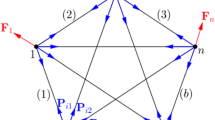Abstract
We develop physically-based models of deformable curves, surfaces, and solids for use in computer graphics. Our deformable models are governed by the mechanical laws of continuous bodies whose shapes can change over time. These laws, expressed in the form of dynamic differential equations, unify the description of shape and motion. By solving the equations numerically we are able to create realistic animations involving the interaction of deformable models with various applied forces, ambient media, and impenetrable obstacles in a simulated physical world. We develop deformable models capable of perfectly elastic behavior and more general inelastic behavior, including viscoelasticity, plasticity, and fracture.
Similar content being viewed by others
References
Alfrey T (1947) Mechanical behavior of high polymers. Interscience, New York, NY
Armstrong WW, Green M (1985) The dynamics of articulated rigid bodies for purposes of animation. The Visual Computer 1:231–240
Barr AH (1984) Global and local deformations of solid primitives. Computer Graphics (Proc SIGGRAPH) 18(3):21–29
Barr A, Barzel R, Haumann D, Kass M, Platt J, Terzopoulos D, Witkin A (1987) Topics in physically-based modeling. ACM SIGGRAPH '87 Course Notes, vol 17, Anaheim, CA
Bartels RH, Beatty JC, Barsky BA (1987) An introduction to splines for use in computer graphics and geometric modeling. Morgan Kaufmann, Los Altos, CA
Barzel R, Barr A (1987) Dynamic Constraints. In: Barr A., et al., (eds) (1987) Topics in physically-based modeling ACM SIGGRAPH '87 Course Notes, vol 17, Auaheim, CA
Blinn JF (1982) A generalization of algebraic surface drawing. ACM Trans Graph 1:235–256
De Boor C (1978) A practical guide to splines. Springer, Berlin Heidelberg New York
Do Carmo MP (1974) Differential geometry of curves and surfaces. Prentice-Hall, Englewood Cliffs, NJ
Christiansen HN (1974) Computer generated displays of structures in vibration. The Shock and Vibration Bulletin 44(2):185–192
Christiansen HN, Benzley SE (1982) Computer graphics displays of nonlinear calculations. Computer methods in applied mechanics and engineering 34:1037–1050
Christensen RM (1982) Theory of viscoelasticity, 2nd ed. Academic Press, New York
Courant R, Hilbert D (1953) Methods of mathematical physics, vol 1. Interscience, London
Faux JD, Pratt MJ (1981) Computational geometry for design and manufacture. Halstead Press, Horwood, NY
Feynman CR (1986) Modeling the Appearance of Cloth, MSc thesis, Department of Electrical Engineering and Computer Science, MIT, Cambridge, MA
Fleischer K, Witkin A (1988) A modeling testbed. Proc Graphics Interface '88. Edmonton, Canada, pp 127–137
Fleischer K, Witkin A, Kass M, Terzopoulos D (1987) Cooking with Kurt. An animated video. Schlumberger Palo Alto Research, Palo Alto, CA
Fournier A, Bloomenthal J, Oppenheimer P, Reeves WT, Smith AR (1987) The modeling of natural phenomena. ACM SIGGRAPH '87 Course Notes, vol 16. Anaheim, CA
Girard M, Maciejewski AA (1985) Computational modeling for the computer animation of legged figures. Computer Graphics (Proc SIGGRAPH) 19(3): 263–270
Goldstein H (1980) Classical mechanics, 2nd edn. Addison-Wesley, Reading, MA
Hackbusch W (1985) Multigrid methods and applications. Springer, Berlin Heidelberg New York
Hansen C, Henderson T (1986) UTAH Range Database, Dept Comput, Univ Utah, Salt Lake City, Utah, TR No. UUCS86-113
Haumann D (1987) Modeling the physical behavior of flexible objects. In: Barr A., et al., (eds) (1987) Topics in physicallybased modeling ACM SIGGRAPH '87 Course Notes, vol 17, Anaheim, CA
Hoffmann CM, Hopcroft JE (1987) Simulation of physical systems from geometric models. IEEE J Robotics and Automation, RA-3(3):194–206
Hunter SC (1983) Mechanics of Continuous Media, 2nd edn. Ellis Horwood, Chishter, England
Issacs PM, Cohen MF (1987) Controlling dynamic simulation with kinematic constrants, behavior functions, and inverse dynamics. Computer Graphics (Proc SIGGRAPH) 21(4):215–224
Kardestuncer H, Norrie DH (eds) (1987) Finite element handbook. McGraw-Hill, New York
Kass M, Witkin A, Terzopoulos D (1987) Snakes: Active contour models. Int J Comput Vision 1:321–331
Landau LD, Lifshitz EM (1959) Theory of elasticity. Pergamon Press, London, UK
Lapidus L, Pinder GF (1982) Numerical solution of partial differential equations in science and engineering. Wiley, New York
Lassiter J (1987) Principles of traditional animation applied to 3D computer animation. Computer Graphics (Proc SIGGRAPH) 21(4):35–44
Luenberger DG (1973) Introduction to linear and nonlinear programming. Addison-Wesley, Reading, MA
Lundin D (1987) Ruminations of a model maker. IEEE Comput Graph Appl 7(5):3–5
Mendelson A (1968) Plasticity — theory and application. Macmillan, New York
Press WH, Flannery BP, Teukolsky SA, Vetterling WT (1986) Numerical recipes: the art of scientific computing. Cambridge University Press, Cambridge, UK
Sederberg TW Parry SR (1986) Free-form deformation of solid geometric models. Comput Graph (Proc SIGGRAPH) 20(4):151–160
Shephard MS, Abel JF (1987) Interactive computer graphics for CAD/CAM. In: Kardestuncer H, Norrie DH, (eds) (1987) Finite Element Handbook McGraw-Hill, New York, pp 4.233–4.254
Sih GC (1981) Mechanics of fracture. Martinus Nijhoff, The Hague
Terzopoulos D (1983) Multilevel computational processes for visual surface reconstruction. Computer Vision, Graphics, and Image Processing 24:52–96
Terzopoulos D (1986) Regularization of inverse visual problems involving discontinuities. IEEE Trans Pattern Anal Mach Intell PAMI-8:413–424
Terzopoulos D (1988) The computation of visible-surface representations. IEEE Trans Pattern Anal Mach Intell PAMI-10:417–438
Terzopoulos D, Platt J, Barr A, Fleischer K (1987a) Elastically deformable models. Comput Graph (Proc. SIGGRAPH) 21(4):205–214
Terzopoulos D, Witkin A (1988) Physically-based models with rigid and deformable components. IEEE Comput Graph Appl 8(6):41–51
Terzopoulos D, Witkin A, Kass M (1987b) Symmetry-seeking models and 3D object reconstruction. Int J Comput Vision 1:211–221
Weil J (1986) The synthesis of cloth objects. Comput Graph (Proc SIGGRAPH) 20(4):49–54
Wilhelms J (1987) Using dynamic analysis for realistic animation of articulated bodies. IEEE Comput Graph Appl 7(6):12–27
Wilhelms J, Barsky BA (1985) Using dynamic analysis to animate articulated bodies such as humans and robots. Proc Graphics Interface '85. Montreal, Canada, pp 97–104
Wyvill B, McPheeters C, Wyvill G (1986) Animating soft objects. The Visual Computer 2:235–242
Zienkiewicz OC (1977) The finite element method, 3rd ed. McGraw-Hill, London
Author information
Authors and Affiliations
Rights and permissions
About this article
Cite this article
Terzopoulos, D., Fleischer, K. Deformable models. The Visual Computer 4, 306–331 (1988). https://doi.org/10.1007/BF01908877
Issue Date:
DOI: https://doi.org/10.1007/BF01908877




